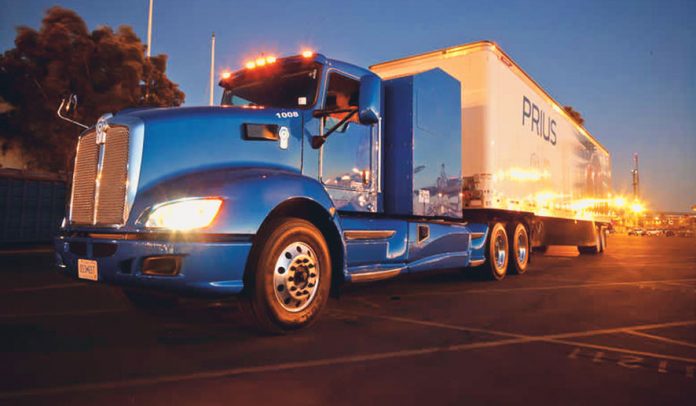Autonomous driving, electrification and digital connectivity enables the advent of smart logistics, while lowering operating costs. CargoTalk speaks to veterans on trends and the industry’s readiness for digital trucking.
With the second largest road network across the world at 5.4 million km, approximately 65 per cent of cargo moves by road in India, as per an IBEF report. During the past three decades, movement of goods by road is gaining considerable momentum in the country, while a growth pause is not expected in demand in the years to come. With the growing demand, digitisation is coming in the industry in a big way. Trucking industry in India has remained the most unorganised and dull among other modes of transportation. Seeing digitisation here might be a bliss for the industry. Cargo Talk explores how digitisation of trucking will transform the logistics value chain in India.
Explaining the concept, Gagandeep S Klaire, Director, Majha Transport, says, “It’s a simple application of technology and re-thinking of the basic trucking fundamentals all together, simply like in modern passenger cars. There is a combination of an ever-changing technologies; trucks will move down the road guided by a wealth of information from transportation infrastructure and other vehicles, improving utilisation through remote maintenance, increasing efficiency, and boosting safety.”
“The biggest concept of digital trucking from the economic front shall be their ability to communicate with fleet management/LSP and with shippers/customer of goods. In the future, cloud-based solutions for freight matching with trucks will eventually be able to determine whether they can take on additional freight. The truck trailer itself will be able to determine its available space and weight, as well as scheduled route, ETA, and other relevant information through sensors and communicate this data to a digital freight-matching platform for quick extra load and thereafter its reverse loads,” he adds.
“It is the next step in the advancement of the logistics sector and it has several aspects to it. The main objective is to improve the overall customer experience and driving excellence in the operations. Digitisation of trucking will help in evaluating the operating performance of the vehicle and the behaviours of the drivers. With the use of available technologies, the fleet owners can link all their fleet to the system and effectively monitor the performance of their fleet,” explains Arindam Bhattacharya, Vertical Head, Holisol Logistics.
Segregating the concept into two, Hari Om Prasad, Regional Head – Transportation, Haiko Logistics India, says, “At a high level, it is the use of data and network-based support systems for managing and optimising trucking transport operations, using many forms of digital technologies and at a process level, it’s the full integration of connected trucks for real-time logistics data across the entire supply chain, from parts and materials suppliers to manufacturers to warehouses and distributors, ending with the end customer.”
“The logistics industry is a rapidly-growing sector which has been transforming at a fast clip with several players working to organise the previously-unorganised sector. Technology has been a major factor influencing this development. Service providers that have deployed cloud-based solutions for internal and/or external business processes e.g., truck sourcing, releasing orders, electronic payments real-time visibility of truck position, sharing the statement of accounts, sharing PoD, electronic invoicing etc, are often referred to as digital logistics service providers. The high interest in digital LSPs is on account of the promise it holds, of delivering – over time – of increasing efficiency of the overall eco-system as well as each player of the ecosystem viz., the consignor, the service provider themselves as well as the fleet owners as also the providers of supplies & services to the industry,” tells Anjani Mandal, CEO & Co-Founder, Fortigo Network Logistics.
Transformed logistics value chain
Emerging tech-focused entrepreneurs are revolutionising the way the industry functioned by leveraging technology to offer seamless, transparent and efficient operations with strict adherence to timelines. Adding to this, Sumit Sharma, Co-Founder & CBRO, GoBOLT, says, “Artificial intelligence, data analytics, and IoT-based technologies are making it easier for entrepreneurs to keep a track on the deliverables, while making fleet management operations easier. It has also helped organisations to control the hours of service for drivers, plan optimised travel routes, while facilitating security through 24×7 surveillance. Fuel sensors, geo-fencing, auto ignition cut-off, retinal sensors, digital locks etc. have completely transformed the way the sector has functioned over the years, driving recruitment of technological talent as well as skill-based resources in the industry. The logistics value chain in India can get transportation solutions such as right vehicle selection, route/delivery planning, real-time tracking, reliable documentation and control, reduced transit time to its clients, which in results facilitates seamless movement of goods from the point of origin to that of consumption and aids significant economic growth in the process.”
Klaire shares, “There has been a great sense of overall improvement in supply chain in India. A decade back, GPS was a luxury in a truck, whereas now it is a mandatory fitting of a new truck.”
“Just as the arrival of the connected car is already changing how carmakers will operate in the future, the advent of the digital truck will completely transform how freight is transported on the highways. Eventually, these trucks will drive themselves, freeing up drivers to take on administrative tasks, and eventually doing away with them altogether.
These advances will have an equally profound effect on the entire logistics system. Trucks will become even more tightly integrated into the entire logistics chain, with the arrival of shipments to factories, warehouses, and end-customers timed precisely, as all the players across the supply chain gain full transparency into the whereabouts of their goods. And ultimately, trucks will be able to communicate their contents and destination with other trucks and with technology platforms that will automatically match shipments with trucks with available space, rerouting them as necessary,” elucidates Prasad.
“Trucking used to be considered as the last dark continent in logistics value chain which was difficult to be conquered due to various factors. However, with the availability of digital technologies, connected network and regular lowering cost of using these technologies, the transformation in trucking has begun. Numerous players in the market are investing into the R&D of the digital platforms and offering innovative solutions to transform the ecosystem. Rivigo started it and now DHL is pushing ahead with driver reforms. Blackbuck and few others took lead in matching the supply and demand to improve the overall capacity utilisation. Use of GPS devices to track the vehicles is increasingly becoming a norm with the organised fleet operators,” points Bhattacharya.
“GST itself is having transformative effect by reducing the bottlenecks and saving the trucking time spent at tolls. Lot of work is happening on route optimisation, blockchain technologies, fleet management, vehicle performance management to drive change and complete transformation of trucking,” he continues.
“At a fundamental level, a cloud-based solution provides information flow within as well as across organisation, including between the supplier and the buyer of product/service. Almost any transaction between two players of the ecosystem gets facilitated with speed and error-free communication, including (a) finding a service provider or a customer (b) order placements (c) shipping document preparation (d) live status of delivery (e) invoicing (f) payments as well as (g) statement of transactions and accounts and reconciliation. Further, it has the potential of creating complete transparency between the two transacting parties,” explains Mandal.
“The goal is to optimise traffic flows, automate routing, improve parking efficiency and safety, and allow drivers to be more efficient. The technology will provide drivers with real-time information about congestion and accidents and automatically update routes. Automated parking features will provide suggestions on where to park depending on the driver’s level of fatigue, no-entry timings, and the traffic situation. The future of driving a truck on Indian road shall be with integration of advanced driving technology such as adaptive cruise control, collision avoidance systems, and radar, also enable trucks to save fuel through platooning: moving down the road in tight convoys, close enough to benefit from the decrease in aerodynamic drag. This technology can save as much as 11 per cent of fuel costs for a three-truck platoon,” informs Klaire.
Adopting change
Logistics industry has always been neglected and so is the appeal. Digitisation will not only bring the efficiency but the charm as well. Now, the question remains is the industry ready to accept the change? On this, Bhattacharya shares, “For the first time in the history on Indian trucking, it seems that a part of industry is beginning to change. The inertia has been broken and we see lot of players now ready to see the benefits of using technology, though largely driven by customers’ minimum requirements. Major manufacturers and distributors are already looking into investing in new technologies as a part of their digitalisation agenda. This will increasingly become important soon as optimising their operations will enable these customers to improve their business performance.” “However, more than 75 per cent of trucking industry remains fragmented and that poses a huge challenge to adopt these changes as the smaller transporters and customers may not feel incentivised to go digital. This will entail huge ecosystem push to get these players on the digital journey and reap the benefits of it,” he continues. Klaire believes, “India has a whole is not ready for the change from larger window as of current market conditions neither their management nor the government or legal policies favour the same. The radical transformation is coming to the Indian trucking and logistics industries over the next 10 or 20 years, which may present many risks but also opportunities for all the players in the business. For few, the risks will be so great that they will likely not survive. For others, success will depend on their ability to understand the opportunities available to them, and to build or buy the capabilities needed to aggressively pursue them. The real risk lies in failing to move forward.” “Digitised trucking will transform how virtually every stakeholder in these linked businesses — original equipment manufacturers (OEMs), logistics companies, warehouses, and local delivery businesses — will operate. Some stakeholders will see a wide range of new business models open, while others will likely struggle as their roles in the logistics chain are diminished,” opines Prasad.
“And in the longer term, the trucking business will likely divide into two distinct markets. Emissions regulations, increased competition, big strides in connectivity, and coming disruptions in the entire logistics chain will primarily affect developed economies. In emerging markets, the issues will involve the need for more reliable and economical trucks, a growing interest in regulating emissions, and strong overall growth prospects, but not necessarily the development of digitised solutions. These distinctions will likely last into the foreseeable
future,” he adds.
“Service level improvements were long desired within the trucking industry. Customer distrust, fragmented operations and lack of adherence to timelines had earned the industry an unenviable reputation. However, the growth of e-commerce and a surge in demand for the services has encouraged many new entrepreneurs to make a straight line for the sector, to an extent that it is being considered the sunshine industry currently. Even established players in the domain are looking forward to implementing technological solutions to reduce operational costs, inefficiencies and earn client trust. The industry is well on the path of tech-driven change and such a transformation is poised to bring some very exciting opportunities for the Indian economy, making its goods more affordable in the world market while driving greater foreign participation,” feels Sharma.















